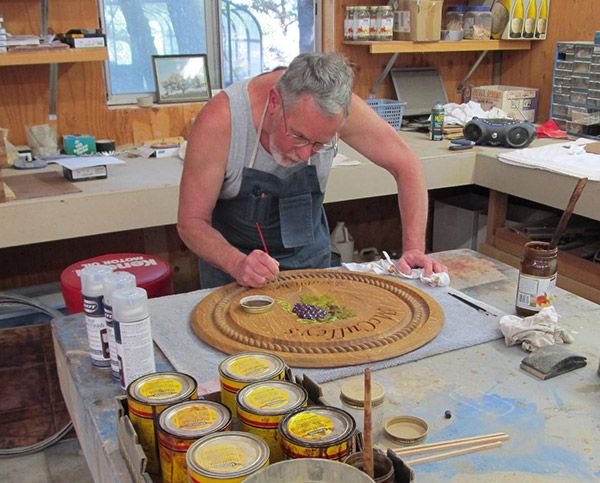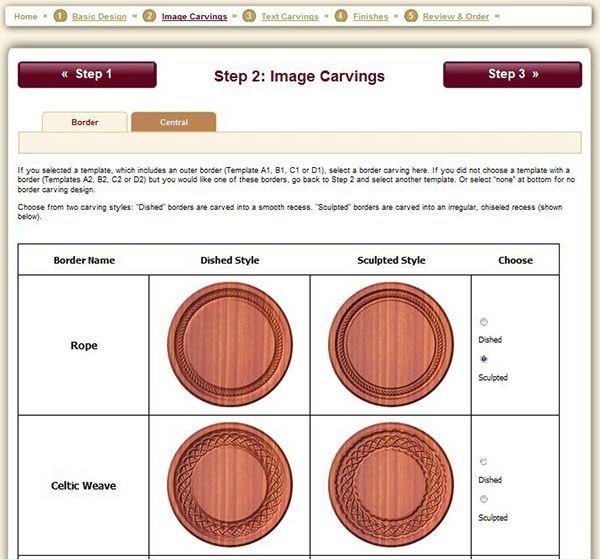
Three years ago at the age of 60, Tom Freeman retired from a career as a software engineer, manager and executive. Tom had enjoyed and benefited from many years of high-risk/high-reward start-ups, 60 hour work weeks, building great teams, products and navigating corporate politics. However, his real passion pointed in a different direction... artisanship. Tom had always enjoyed designing and producing beautiful, high quality objects from wood, metal, stone, etc. which he and others could incorporate into their home and business environments and enjoy for a lifetime.
For years Tom had been looking for ways to integrate his experience with technology with his love of artisanship and woodworking. To further this, once he left the corporate world he decided to purchase a Shopbot CNC router to explore it's possibilities. The first few projects were carvings and signs for family and friends, these were well received and Tom was often complemented on his craftsmanship. It was at this time that he realized that CNC could be viable as a post-retirement business. It was especially attractive that this business would be internet based leveraging Tom's experience within that area and allow him and his wife Marie to live and work wherever they pleased. Tom also wanted to provide a way for his customers to participate in the creative process of designing their own heirloom quality products.
The vision behind Tom and Marie's business; www.eWoodArt.comincorporates all of these ideas and influences. The site enables customers to design or customize their own personalized works of wood-art, to view photo-realistic design proofs of the finished products and then order them if they desire. The current focus is on "wine inspired wood art" targeting individual wine lovers as well as wine-oriented businesses like wineries, tasting rooms, wine bars and restaurants. All current products (barrel head carvings, clocks, tasting tables, lazy susans, stave signs and wine racks) are made from high quality retired french oak wine barrels. The products are produced in a 2400 sq ft shop on the Freemans' Rogue Riverfront compound in Southern Oregon (below left) and shipped to customers all over North America. The Freemans chose this market because they live in the heart of wine country and have ready access to the raw materials. Longer term they expect to apply the same approaches to other markets e.g. marine, equestrian and automotive for customer designed or customized wood artisan products.
eWoodArt's products are designed and produced with the aid of Vectric's Aspire software, lots of Vector Art 3D models and a ShopBot CNC router. Tom explains his decision to utilize these tools,
"When I decided to buy a CNC router I did a lot of research on the Internet. I studied all the major brands looking for the best value in a smaller machine. I compared specs and read lots of reviews and discussions on various user forums. As I was zeroing in on a ShopBot, I learned that a user group meeting was scheduled nearby in the San Francisco Bay Area in conjunction with a "Maker's Faire" where some of their machines would be demonstrated. I attended the fair and the user group meeting and was sold on the quality of the product. ShopBot was selling two of the demo machines at a discount so they would not have to ship them all the way back home to the East Coast, so I bought one on the spot.
The machine came bundled with Partworks and Partworks 3D (the ShopBot branded versions of Vectric's VCarve Pro and Cut3D software) which we used very successfully in our early projects. It soon become apparent we needed more sophisticated and powerful software for our 3D work, this is when I began looking at the leading higher-end products out there. At that time Vectric was just introducing Aspire V1 and although it lacked some of the more advanced capabilities of more mature products it could do everything we needed and more, plus it was priced very attractively. It was supported by Vectric's excellent customer service and the learning curve was short due to its roots in the Vectric software we were already using. We have been completely satisfied with Aspire and continue to discover capabilities it has that can enhance our projects.
Our ShopBot also came with a few sample 3D models from VectorArt3D. After more online research I came to the conclusion that they offered the best over-all quality and value in 3D models for CNC. We bought several collections initially and continue to buy other individual models regularly. We use many different models extensively in our work, especially wine and western themed ones."
The eWoodArt.com web site is at the heart of both the marketing and the design processes, Tom explains the importance of this online resource.
"Serving a small niche market like ours would be virtually impossible without the broad reach of the Internet. We spent a lot of time and resources building a great site and learning how to leverage Internet marketing strategies including our newsletter, emails, pay per click, search engine optimization and most recently, social media to get the word out. In the process we've discovered potentially large niches adjacent to our niche, such as the huge hospitality industry where interest in wine related decor for restaurants and bars is very high.
As for the customer design process, the name eWoodArt came about from our original vision of enabling internet users to interactively design a wood carving online and see it take shape on screen in real time. While fully implementing this vision has not yet been achieved and is a lot harder than we imagined, it is still a direction we want to head in. In the meantime we provide a good first step. Our site includes an online design flow for our flagship product (barrel head carvings), that allows a customer to select from a range of design templates, then selectively add design elements including 3D carvings, text and custom 2D artwork like logos & ranch brands. Customers "submit" their design to us through the website and we produce and email back a free photo realistic design proof (and a firm price quote to produce it) usually the same day. The highly realistic quality of Aspire's "preview images" is a great tool to allow the customer to visualize the product and gain the confidence to buy."
Barrel Head Design
eWoodArt ships products from its growing catalog of customizable offerings as well as "one-off" completely custom products requested by larger customers. When working on their "flagship" barrel head carvings product, the customer can choose from a stock set of options or have a unique design created which is based on their own artwork.
The screen shot (above) is from the barrel head carving design tool that collects the users input. In this case letting them choose the optional border decoration. You may recognize the two 3D border carving options in the screenshot as VectorArt3D models. Tom previously described the design process where they define their customers requirements, from collecting the customer's design choices using the website through to working with Aspire to generate and finalize design proofs. Below is an example of the customers final design proof, in this case though the Barrel Head carving is unique in a couple of different ways which Tom goes on to explain.
"Firstly, unlike most of the hundreds of barrel head carvings we've produced this uses a logo design supplied by the customer and doesn't use any of our "stock" VectorArt3D models.
Secondly, we wanted the turtle shell in the logo to really pop out, so we turned the flat logo vectors into a deep 3D model and glued a 1" thick slab of white oak onto the face of the 1" barrel head to give us plenty of depth to work with. Turning 2D logo artwork into 3D can be a mixed bag. On one hand you can get some stunning, original effects like this, then on the other hand corporate brand purists aren't always receptive to us taking such liberties with their logos. In this case the customer was extremely supportive of the idea. After cleaning up the vectors supplied by the customer we simply applied Aspire's "Create 3D Shape" function to the shell perimeter vector to create the rounded profile. Then we projected the shell grooves and text onto that."
Barrel Head Production
Once the customers design requirements have been finalized then the part goes into production using specialized materials and a custom process devised by Tom. Below he describes the material they use and the steps that are taken to produce a complete custom barrel head.
"We buy only the highest quality French oak barrels for these products. This particular wood in our opinion is the thickest, densest, clearest, highest quality, most beautifully quarter sawn oak you can get. It comes from old growth forests mostly in France.
The first step in production of a "tenth barrel" in the shop is to saw off the end of the barrel head, generally just below the second hoop. We then place the cut off barrel head on our router and route out a circular recess around the inside perimeter of the side staves. Following this we then glue in a round plywood backing (also precisely cut with our router), this enhances the finished piece's structural integrity and adds a surface to mount it on later.
The plywood backing is actually 2 half circles. Once the glue has cured we can remove the 2 hoops and pull apart the 2 halves of the tenth barrel, freeing the flat barrel head. The flat round head is removed and the head staves are separated, cleaned and glued in a specially constructed clamp, this helps ensure that the head does not crack or separate due to changing moisture content.
The glued up head is then returned to the router and planed down absolutely flat to expose fresh new oak. After generating multiple toolpaths and using a variety of carving bits the finished carving emerges.
The carved head is then hand sanded to perfection, stained, sealed and painted as specified by our customer. Meanwhile the steel hoops are reconditioned by pounding out any dents and painting them, typically with a "hammered silver" paint in order to restore the like-new look of the metal. The outer curved stave "shell" of the tenth barrel is sanded and finished. Finally the flat barrel head is re-united with the shell and hoops which are then securely screwed back on.
The final step is spraying on a "topcoat" of lacquer or spar urethane to provide a beautiful long lasting finish. All this is aimed at delivering a stunning, heirloom quality piece of custom wood art that will endure and delight for generations. Above right is a photo of the finished barrel head for B&B Winery."








Vectric Ltd
Precision House
2 Arden Road
Alcester
B49 6HN
GB115123072
Privacy Policy |
Terms and Conditions